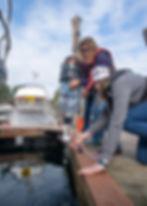LARVAL CRAB MONITORING

What is the best predictor of adult crab biomass?
This question was determined by PCRG members to be our top research priority and, thus, a guide toward the development of our first coordinated research study. A long-term larval crab monitoring study in Coos Bay, Oregon by Dr. Alan Shanks (University of Oregon) provided evidence that larval crab abundance can predict adult crab abundance four years after the larvae are caught.
We decided to build off of this model and determine whether it could also work in Washington by developing a statewide larval crab study using light traps deployed off of docks and piers to capture Dungeness crab larvae and provide estimates of abundance. Beyond serving as a potential predictor of adult crab biomass, larval crab can be considered a sentinel species, shining a light on changing ocean conditions and providing insight into broader ecosystem dynamics.
OUR METHODS
PCRG partners use standardized light traps to capture and count Dungeness crab larvae. Each light trap is constructed using a water bottle with funnels on the side, a buoyant lid, and an LED light in the center that turns on at sunset and off at sunrise. Larval crab exhibit positive phototaxis, meaning they are attracted to light. We can take advantage of this behavior with our light traps, which are especially effective at capturing megalopae, the second developmental stage of crab.



LIGHT TRAP SITES
See Where the Research is Happening!
The map below shows all PCRG light trap site locations active between 2019 and the current monitoring season.
Check out https://sentinels.hakai.org to see our partners in British Columbia!



WHAT WE CATCH
Our light traps attract a wide array of marine life. Scroll through the photos below to see some of the species we've encountered!


















TECHNICAL TEAM
The Larval Crab Technical Team guides the planning and coordination of all light trap monitoring efforts for PCRG’s Larval Crab Working Group. From developing research protocols to overseeing data collection and analysis, they turn observations into insights, sharing results that advance our understanding of larval crab dynamics across the Pacific Northwest.






